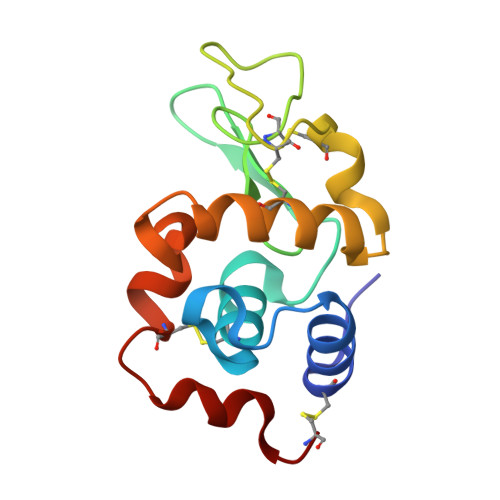Orthorhombic lysozyme crystallization at acidic pH values driven by phosphate binding.
Plaza-Garrido, M., Salinas-Garcia, M.C., Camara-Artigas, A.(2018) Acta Crystallogr D Struct Biol 74: 480-489
- PubMed: 29717719
- DOI: https://doi.org/10.1107/S205979831800517X
- Primary Citation of Related Structures:
6F1L, 6F1M, 6F1O, 6F1P, 6F1R, 6F9X, 6F9Y, 6F9Z, 6FA0 - PubMed Abstract:
The structure of orthorhombic lysozyme has been obtained at 298 K and pH 4.5 using sodium chloride as the precipitant and in the presence of sodium phosphate at a concentration as low as 5 mM. Crystals belonging to space group P2 1 2 1 2 1 (unit-cell parameters a = 30, b = 56, c = 73 Å, α = β = γ = 90.00°) diffracted to a resolution higher than 1 Å, and the high quality of these crystals permitted the identification of a phosphate ion bound to Arg14 and His15. The binding of this ion produces long-range conformational changes affecting the loop containing Ser60-Asn74. The negatively charged phosphate ion shields the electrostatic repulsion of the positively charged arginine and histidine residues, resulting in higher stability of the phosphate-bound lysozyme. Additionally, a low-humidity orthorhombic variant was obtained at pH 4.5, and comparison with those previously obtained at pH 6.5 and 9.5 shows a 1.5 Å displacement of the fifth α-helix towards the active-site cavity, which might be relevant to protein function. Since lysozyme is broadly used as a model protein in studies related to protein crystallization and amyloid formation, these results indicate that the interaction of some anions must be considered when analysing experiments performed at acidic pH values.
- Department of Chemistry and Physics, Agrifood Campus of International Excellence (ceiA3) and CIAMBITAL, University of Almería, Carretera de Sacramento, 04120 Almeria, Spain.
Organizational Affiliation:


















